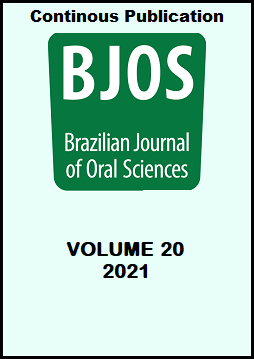Abstract
Mood disorders such as stress and depression can promote alterations of several hormones Aim: The present study aimed to evaluate if symptoms of depression and stress are associated with halitosis. The hypothesis is that halitosis is associated with stress and depression symptoms. Methods: All university students’ entrants in the Federal University of Pelotas (UFPel) were invited to participate. Self-reported halitosis was measured using a visual analog scale. Students were also asked about the presence of halitosis perceived by close individuals. The stress level was measured using a modified version of the Perceived Stress Scale and symptoms of depression were screened by Patient Health Questionnaire-2. Poisson Regression Models were performed. Results: Of a total of 2,058 students who participated in the study, only 16% of them have reported not having any degree of halitosis and 17.6% were informed of closed individuals having halitosis. After adjustments, stress and depression symptoms remained associated with halitosis selfreported. Individuals from the higher stressed quartile presented higher scores of halitosis (RR 1.37 CI95% [1.24–1.53]). Students who presented depressive symptoms showed higher scores of self-perceived halitosis (RR 1.20 CI95% [1.10–1.32]). When the association of stress and halitosis reported by close individuals was tested, symptoms of depression lost the association in the adjusted model, while individuals from the highest quartile from stress remained associated (PR 1.36 CI95% [1.02–1.81]). Conclusion: Halitosis was associated with stress even after control for oral health and socioeconomic variables.
References
Silva MF, Leite FRM, Ferreira LB, Pola NM, Scannapieco FA, Demarco FF, et al. Estimated prevalence of halitosis: a systematic review and meta-regression analysis. Clin Oral Investig. 2018 Jan;22(1):47-55. doi: 10.1007/s00784-017-2164-5.
Al-Ansari JM, Boodai H, Al-Sumait N, Al-Khabbaz AK, Al-Shammari KF, Salako N. Factors associated with self-reported halitosis in Kuwaiti patients. J Dent. 2006 Aug;34(7):444-9. doi: 10.1016/j.jdent.2005.10.002.
Kim SY, Sim S, Kim SG, Park B, Choi HG. Prevalence and associated factors of subjective halitosis in korean adolescents. PLoS One. 2015 Oct;10(10):e0140214. doi: 10.1371/journal.pone.0140214.
Lee E, Lee YH, Kim W, Kho HS. Self-reported prevalence and severity of xerostomia and its related conditions in individuals attending hospital for general health examinations. Int J Oral Maxillofac Surg. 2014 Apr;43(4):498-505. doi: 10.1016/j.ijom.2013.10.011.
Takiguchi T, Yoshihara A, Takano N, Miyazaki H. Oral health and depression in older Japanese people. Gerodontology. 2016 Dec;33(4):439-46. doi: 10.1111/ger.12177.
Yaegaki K, Coil JM. Genuine halitosis, pseudo-halitosis, and halitophobia: classification, diagnosis, and treatment. Compend Contin Educ Dent. 2000 Oct;21(10A):880-6, 888-9; quiz 890.
Rosenberg M, Kozlovsky A, Gelernter I, Cherniak O, Gabbay J, Baht R, et al. Self-estimation of oral malodor. J Dent Res. 1995 Sep;74(9):1577-82. doi: 10.1177/00220345950740091201.
Seemann R, Bizhang M, Djamchidi C, Kage A, Nachnani S. The proportion of pseudo-halitosis patients in a multidisciplinary breath malodour consultation. Int Dent J. 2006 Apr;56(2):77-81. doi: 10.1111/j.1875-595x.2006.tb00077.x.
Colussi PR, Hugo FN, Muniz FW, Rosing CK. Oral health-related quality of life and associated factors in brazilian adolescents. Braz Dent J. 2017;28(1):113-20. doi: 10.1590/0103-6440201701098.
Ludwig AB, Burton W, Weingarten J, Milan F, Myers DC, Kligler B. Depression and stress amongst undergraduate medical students. BMC Med Educ. 2015 Aug;15:141. doi: 10.1186/s12909-015-0425-z.
Chisini L, Cademartori M, Colares C, Tarquinio S, Goettems M, Demarco F, et al. Methods and logistics of an oral health cohort of university students from Pelotas, a Brazilian Southern city. Braz J Oral Sci. 2019;18:e191460. doi: 10.20396/bjos.v18i0.8655316.
Chisini L, Cademartori M, Collares C, Pires A, Corrêa M, Demarco F. Desire of university students for esthetic treatment and tooth bleaching: a cross-sectional study. Braz J of Oral Sci. 2019;18:e191648. doi: 10.20396/bjos.v18i0.8657267.
Chisini L, Queiroz A, Lima F, Silva L, Cademartori M, Costa F, et al. Is obesity associated with tooth loss due to caries? A Cross-sectional study. Braz J of Oral Sci. 2020;19:e201088. doi: 10.20396/bjos.v19i0.8661088.
White RS, Jiang J, Hall CB, Katz MJ, Zimmerman ME, Sliwinski M, et al. Higher Perceived Stress Scale scores are associated with higher pain intensity and pain interference levels in older adults. J Am Geriatr Soc. 2014 Dec;62(12):2350-6. doi: 10.1111/jgs.13135.
Fukui M, Hinode D, Yokoyama M, Yoshioka M, Kataoka K, Ito HO. Levels of salivary stress markers in patients with anxiety about halitosis. Arch Oral Biol. 2010 Nov;55(11):842-7. doi: 10.1016/j.archoralbio.2010.07.014.
Beiter R, Nash R, McCrady M, Rhoades D, Linscomb M, Clarahan M, et al. The prevalence and correlates of depression, anxiety, and stress in a sample of college students. J Affect Disord. 2015 Mar;173:90-6. doi: 10.1016/j.jad.2014.10.054.
Tafet GE, Toister-Achituv M, Shinitzky M. Enhancement of serotonin uptake by cortisol: a possible link between stress and depression. Cogn Affect Behav Neurosci. 2001 Mar;1(1):96-104. doi: 10.3758/cabn.1.1.96.
Tafet GE, Idoyaga-Vargas VP, Abulafia DP, Calandria JM, Roffman SS, Chiovetta A, et al. Correlation between cortisol level and serotonin uptake in patients with chronic stress and depression. Cogn Affect Behav Neurosci. 2001 Dec;1(4):388-93. doi: 10.3758/cabn.1.4.388.
Caspi A, Sugden K, Moffitt TE, Taylor A, Craig IW, Harrington H, et al. Influence of life stress on depression: moderation by a polymorphism in the 5-HTT gene. Science. 2003 Jul 18;301(5631):386-9. doi: 10.1126/science.1083968.
Ben Loubir D, Serhier Z, Diouny S, Battas O, Agoub M, Bennani Othmani M. Prevalence of stress in Casablanca medical students: a cross-sectional study. Pan Afr Med J. 2014 Oct;19:149. doi: 10.11604/pamj.2014.19.149.4010.
Monroe SM, Slavich GM, Gotlib IH. Life stress and family history for depression: the moderating role of past depressive episodes. J Psychiatr Res. 2014 Feb;49:90-5. doi: 10.1016/j.jpsychires.2013.11.005.
Chisini LA, San Martin AS, Cademartori MG, Boscato N, Correa MB, Goettems ML. Interventions to reduce bruxism in children and adolescents: a systematic scoping review and critical reflection. Eur J Pediatr. 2020 Feb;179(2):177-89. doi: 10.1007/s00431-019-03549-8.
Chisini LA, Conde MC, Correa MB, Dantas RV, Silva AF, Pappen FG, et al. Vital Pulp Therapies in Clinical Practice: Findings from a Survey with Dentist in Southern Brazil. Braz Dent J. 2015;26(6):566-71. doi: 10.1590/0103-6440201300409.

This work is licensed under a Creative Commons Attribution 4.0 International License.
Copyright (c) 2021 Brazilian Journal of Oral Sciences


